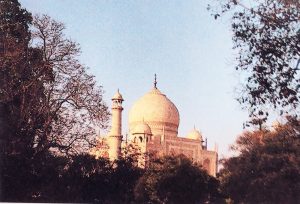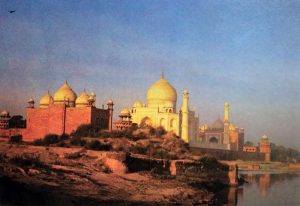How you can take photographs of the Taj Mahal for best results.
As the most photographed edifice in the country, images of the Taj Mahal have appeared in books, magazine articles, calendars, postcards, even on t-shirts and as advertisements for tea and Scotch whisky!
You’ll find it at once marvellously easy to photograph, as well as extremely difficult. Easy because of its sheer visual appeal, and difficult because after more than a century of being captured on film by thousands of photographers, there remains no new, undiscovered angle.
The Taj is special for a number of reasons, and as a potential amateur photographer you would do well to keep them in mind. First is the utter simplicity and feminity of its outline. Its marble inlay work is restrained rather than profuse, the better to highlight the lustre of the marble. Compare, for instance, the ornamental bands of inlay work on the Taj to today’s marble crafts available in innumerable tourist shops. Delicacy and grace of outline, as well as restrained decoration which highlights rather than overshadows the marble, are arts that have been lost with the passage of time. Then too, the bodies of water that surround the monument serve to reflect its perfection in the same manner as a beautiful woman’s reflection in a mirror.
Secondly, the material of which the Taj is built—pristine white marble—underscores its delicacy. Can you imagine what it would have looked like, made of red sandstone? By virtue of the whiteness of its marble, it takes on the colour of the sun at different times of the day - grey at dawn and dusk; golden at sunrise, dazzling white throughout the day and pink at sunset. There are seasonal variations too. In winter, mists envelop the structure; during the summer, the dust laden air gives the Tai a flat, unidimensional appearance, and during the monsoon, dark clouds counterpoint its whiteness. This is a factor that most visitors do not take into account when they alight from their tourist coaches, tramp in and around the monument for an average 15 minutes after taking the mandatory shot at the entrance gateway, only to return to their buses.
Thirdly, its location. Go through any literature on the Taj, and you will notice that the Taj Mahal has been virtually isolated from its surrounding monuments. The enclosing walls on three sides, the south, east and west gateways, the entrance gate, the mosque and rest house have been ignored as if they stand there by mere coincidence! Shah Jehan however conceptualised the tomb of his empress in concert with the rest of the complex. Not to realise this is to do his superb visu-alisation a grave injustice.
Because of the height of the plinth, the Taj Mahal is visible for miles—from the east along the river at what is now the Taj tannery; from the west—the Agra Fort and the river bed under the neighbouring bridge; from the north across the river; and from the south where it rises majestically amid low rooflines of brick houses in Taj Gunj. Then too, many hotels in Agra Cantt overlook the Taj Mahal, affording ever-changing perspectives to the enterprising photographer in you.
From all this, it should be clear that top-of-the-line equipment and high powered lenses are no substitute for an ‘eye’ and some patience. For now that getting a picture of the Taj from a unique angle is virtually impossible, we are going to concentrate on taking beautiful pictures of the way we view the structure.
Few are lucky enough to possess a varied focal lengths - most of you must make do with what you have—a simple box camera or fully automatic camera, which in both cases are fitted with 35mm lenses. This is ideal for shots of the Taj from any point within its own grounds, especially for pictures of the monument and its reflection in pools of water. The only limitation of such a lens is that taking shots from afar are normally unsuccessful. When taking long shots, try to get as interesting a background as possible—brilliant red sky or dark brooding clouds. The best time for this is during the monsoon months. At this time of the year there is another advantage : the River Yamuna swells appreciably, providing interesting reflections.
Walk around the gardens which have been sensitively landscaped with clusters of areca palms which add interest to the foreground. Each of you will discover your own favourite spot - mine is from the plinth of what is now the museum building, where the evening light constantly changes the tints of the dome, framed by feathery cascades of gulmohur leaves.
Because the importance of the Taj Mahal virtually overshadows every other monument in the country, the Archaeological Survey of India spends considerable time and effort on its maintenance. This means that scaffolding is erected over one or the other exterior wall almost permanently, so that you will have to frame your photograph carefully.
Also, in the last couple of years, terrorist threats have enforced tighter security. Visitors could not till recently visit the Taj at night -in former years visitors thronged the complex on full moon nights; climbing to the first floor of any of the surrounding buildings within the complex is prohibited. It is, however, possible to obtain prior permission to use a movie / video camera and to ascend to the top floor of any of the structures in the complex from the Director, Archaeological Survey of India who will issue a letter to that effect. Failing that, there are some guest houses and private homes in Taj Gunj which have a magnificent view of the Taj Mahal. Some of these are popular with tourists who can take pictures of the Taj by moonlight or use video cameras.
It is by now apparent that anyone can take good pictures of the Taj. All that is needed is time, preferably over several seasons of the year. Lush gardens, still reflections, nature’s moods, even the crowds that visit the Taj Mahal can, indeed must, be used to emphasie its beauty.



